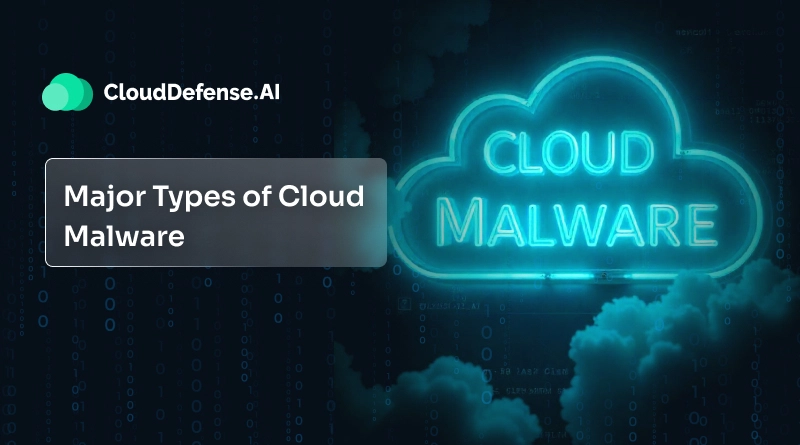Major Types of Cloud Malware
As cloud computing becomes foundational for modern businesses, it’s also opened up new opportunities for cybercriminals. One of the most serious threats emerging today is cloud malware—a stealthy, sophisticated form of attack targeting cloud-native environments. With the majority of malware now leveraging cloud-based apps to infiltrate systems, it’s no longer a threat you can afford to ignore. What Is Cloud Malware and Why Should You Be Concerned? Cloud malware refers to malicious software designed to exploit cloud platforms and services. Unlike traditional threats that target physical devices, cloud malware often hides within cloud workloads, APIs, or third-party integrations—making detection harder and attacks more damaging. Its ability to move laterally across interconnected systems means that a single compromise can quickly affect multiple environments, causing widespread disruption and potential data breaches. How Cloud Malware Impacts Organizations Businesses that rely on the cloud for operations, customer engagement, and data storage face serious consequences if cloud malware breaches their defenses. From service downtime and reputational damage to regulatory penalties and financial loss, the implications are severe. According to IBM, the average data breach now costs over $5 million, with cloud malware playing a growing role in these incidents. Common Types of Cloud Malware Understanding the tactics used by attackers helps in building more resilient defenses. Here are several forms cloud malware can take: API & Injection Exploits: Attackers insert malicious commands through weak or outdated APIs. Credential Theft: Compromising login credentials through phishing or brute-force attacks. Trojans in Disguise: Malware posing as legitimate software to gain system access. Serverless Threats: Exploiting unsecured functions in serverless architectures. Data Exfiltration & Destruction: Stealing or corrupting cloud-stored information. Zero-Day Attacks: Targeting unknown vulnerabilities before fixes are available. WiFi Interception: Eavesdropping on unsecured networks to access cloud assets. Best Practices to Minimize Cloud Malware Risks Enable Multi-Factor Authentication across all user accounts. Apply regular software and API updates to eliminate known vulnerabilities. Encrypt critical data both during transmission and at rest. Conduct ongoing cloud activity monitoring using behavioral analytics. Educate teams on phishing awareness and secure credential handling. Back up cloud data routinely to ensure business continuity in case of an attack. Strengthen Your Cloud Defenses with CloudDefense.AI For a unified and intelligent approach to cloud malware protection, CloudDefense.AI delivers a robust CNAPP platform that secures your entire cloud stack—from source code to runtime. With built-in tools for SAST, DAST, IaC scanning, CSPM, CIEM, and more, CloudDefense.AI detects threats early, prioritizes real vulnerabilities, and automates response. Take control of your cloud security—request a free demo today.


As cloud computing becomes foundational for modern businesses, it’s also opened up new opportunities for cybercriminals. One of the most serious threats emerging today is cloud malware—a stealthy, sophisticated form of attack targeting cloud-native environments. With the majority of malware now leveraging cloud-based apps to infiltrate systems, it’s no longer a threat you can afford to ignore.
What Is Cloud Malware and Why Should You Be Concerned?
Cloud malware refers to malicious software designed to exploit cloud platforms and services. Unlike traditional threats that target physical devices, cloud malware often hides within cloud workloads, APIs, or third-party integrations—making detection harder and attacks more damaging.
Its ability to move laterally across interconnected systems means that a single compromise can quickly affect multiple environments, causing widespread disruption and potential data breaches.
How Cloud Malware Impacts Organizations
Businesses that rely on the cloud for operations, customer engagement, and data storage face serious consequences if cloud malware breaches their defenses. From service downtime and reputational damage to regulatory penalties and financial loss, the implications are severe. According to IBM, the average data breach now costs over $5 million, with cloud malware playing a growing role in these incidents.
Common Types of Cloud Malware
Understanding the tactics used by attackers helps in building more resilient defenses. Here are several forms cloud malware can take:
- API & Injection Exploits: Attackers insert malicious commands through weak or outdated APIs.
- Credential Theft: Compromising login credentials through phishing or brute-force attacks.
- Trojans in Disguise: Malware posing as legitimate software to gain system access.
- Serverless Threats: Exploiting unsecured functions in serverless architectures.
- Data Exfiltration & Destruction: Stealing or corrupting cloud-stored information.
- Zero-Day Attacks: Targeting unknown vulnerabilities before fixes are available.
- WiFi Interception: Eavesdropping on unsecured networks to access cloud assets.
Best Practices to Minimize Cloud Malware Risks
- Enable Multi-Factor Authentication across all user accounts.
- Apply regular software and API updates to eliminate known vulnerabilities.
- Encrypt critical data both during transmission and at rest.
- Conduct ongoing cloud activity monitoring using behavioral analytics.
- Educate teams on phishing awareness and secure credential handling.
- Back up cloud data routinely to ensure business continuity in case of an attack.
Strengthen Your Cloud Defenses with CloudDefense.AI
For a unified and intelligent approach to cloud malware protection, CloudDefense.AI delivers a robust CNAPP platform that secures your entire cloud stack—from source code to runtime. With built-in tools for SAST, DAST, IaC scanning, CSPM, CIEM, and more, CloudDefense.AI detects threats early, prioritizes real vulnerabilities, and automates response.
Take control of your cloud security—request a free demo today.




























![[Webinar] AI Is Already Inside Your SaaS Stack — Learn How to Prevent the Next Silent Breach](https://blogger.googleusercontent.com/img/b/R29vZ2xl/AVvXsEiOWn65wd33dg2uO99NrtKbpYLfcepwOLidQDMls0HXKlA91k6HURluRA4WXgJRAZldEe1VReMQZyyYt1PgnoAn5JPpILsWlXIzmrBSs_TBoyPwO7hZrWouBg2-O3mdeoeSGY-l9_bsZB7vbpKjTSvG93zNytjxgTaMPqo9iq9Z5pGa05CJOs9uXpwHFT4/s1600/ai-cyber.jpg?#)











































































































































![[The AI Show Episode 144]: ChatGPT’s New Memory, Shopify CEO’s Leaked “AI First” Memo, Google Cloud Next Releases, o3 and o4-mini Coming Soon & Llama 4’s Rocky Launch](https://www.marketingaiinstitute.com/hubfs/ep%20144%20cover.png)





























































































































![[FREE EBOOKS] Machine Learning Hero, AI-Assisted Programming for Web and Machine Learning & Four More Best Selling Titles](https://www.javacodegeeks.com/wp-content/uploads/2012/12/jcg-logo.jpg)








































































![Rogue Company Elite tier list of best characters [April 2025]](https://media.pocketgamer.com/artwork/na-33136-1657102075/rogue-company-ios-android-tier-cover.jpg?#)








































































_Andreas_Prott_Alamy.jpg?width=1280&auto=webp&quality=80&disable=upscale#)





























































































![What’s new in Android’s April 2025 Google System Updates [U: 4/18]](https://i0.wp.com/9to5google.com/wp-content/uploads/sites/4/2025/01/google-play-services-3.jpg?resize=1200%2C628&quality=82&strip=all&ssl=1)










![Apple Watch Series 10 Back On Sale for $299! [Lowest Price Ever]](https://www.iclarified.com/images/news/96657/96657/96657-640.jpg)
![EU Postpones Apple App Store Fines Amid Tariff Negotiations [Report]](https://www.iclarified.com/images/news/97068/97068/97068-640.jpg)
![Apple Slips to Fifth in China's Smartphone Market with 9% Decline [Report]](https://www.iclarified.com/images/news/97065/97065/97065-640.jpg)


































































































































